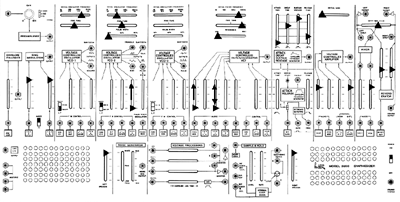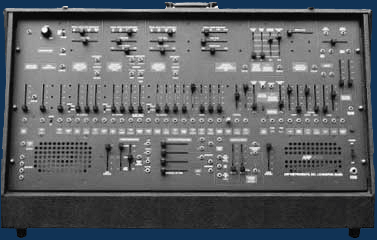Patch 1: Marimba Roll
The ARP patch book is a curious artifact. With patch names like "Trucker Bass" and "Small Barking Mutt", it's obvious that the authors had fun writing it. (The same goes for the owners manual, which is, oddly enough, quite funny.) So anyway, a romp through these hallowed pages may turn out to be more fun than I anticipated.
That said, patch number one has a fairly mundane name: Marimba Roll. It's supposed to sound like ... well, mallets doing a roll on a marimba. Here it is:
Here's the patch:

(Click for a full-size PDF.)
Not very "marimba"-like I suppose. It actually came out sort of hearts of space. That's not a bad thing, just not something I've ever done before. The spacy-ness (not to be confused with spaceship-ness) results from two factors. First, I am just learning how to use the instrument, and I didn't feel confident in tackling a musical style that would require more, how you say, finesse? Second, I'm still working through some recording issues on the MBox, and I can't quite overdub in real time with recorded tracks yet (there's a slight delay). I'll be a bit more adventurous as I figure that out (the next patch is "trumpet and french horn" ... watch out!)
Where did this piece come from, musically? For starters, I've been spending a lot of time with Cygnus X-1 (a Rush tune, thanks to Nuje for the introduction), and there's a solo guitar part in it with fast octaves. This sound reminded me of that part, so I started out using that as a target in my mind. Things quickly descended from there, and I made lots of use of sweeping the faders for the filter frequency and resonance. I did 3 basic tracks of octave swells, and panned them left, right and middle (with a bit of reverb). I then added a noodly little background part (Uberjam referred to it as the sound of petting a soft, tubular underwater creature.)
After about a dozen listens through, I decided it needed a little more "marimba" (that's the ring modulator effect creating that mallet-striking-wood sound) and faded in a high moving line, with a stereo slap delay (so it sounds like it's way out to the left and right). That did the trick - not too overbearing, but still interesting to listen to.
Let me know what you think!
That said, patch number one has a fairly mundane name: Marimba Roll. It's supposed to sound like ... well, mallets doing a roll on a marimba. Here it is:
 | 01: Marimba Roll (mp3, 3MB) |
Here's the patch:

(Click for a full-size PDF.)
Not very "marimba"-like I suppose. It actually came out sort of hearts of space. That's not a bad thing, just not something I've ever done before. The spacy-ness (not to be confused with spaceship-ness) results from two factors. First, I am just learning how to use the instrument, and I didn't feel confident in tackling a musical style that would require more, how you say, finesse? Second, I'm still working through some recording issues on the MBox, and I can't quite overdub in real time with recorded tracks yet (there's a slight delay). I'll be a bit more adventurous as I figure that out (the next patch is "trumpet and french horn" ... watch out!)
Where did this piece come from, musically? For starters, I've been spending a lot of time with Cygnus X-1 (a Rush tune, thanks to Nuje for the introduction), and there's a solo guitar part in it with fast octaves. This sound reminded me of that part, so I started out using that as a target in my mind. Things quickly descended from there, and I made lots of use of sweeping the faders for the filter frequency and resonance. I did 3 basic tracks of octave swells, and panned them left, right and middle (with a bit of reverb). I then added a noodly little background part (Uberjam referred to it as the sound of petting a soft, tubular underwater creature.)
After about a dozen listens through, I decided it needed a little more "marimba" (that's the ring modulator effect creating that mallet-striking-wood sound) and faded in a high moving line, with a stereo slap delay (so it sounds like it's way out to the left and right). That did the trick - not too overbearing, but still interesting to listen to.
Let me know what you think!


